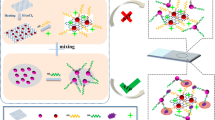Abstract
In the pH 6.6 Na2HPO4–NaH2PO4 buffer solutions and in the presence of urease catalyst, urea can be decomposed to form NH4 +. The NH4 + reacted with sodium tetraphenyl boron (NaTPB) to form the association particles that exhibited a resonance scattering (RS) peak at 474 nm. When the urea concentration increased, NH4 + increased, and RS intensity at 474 nm enhanced linearly. Under the chosen conditions, the increased RS intensity (ΔI 474 nm) had a linear response to the urea concentration in the range of 0.125–15 μM, with a detection limit of 0.058 μM urea, and a regression equation of ΔI 474 nm = 31.6C + 2.1, a correlation coefficient of 0.9986. This catalytic RS method was applied for the detection of urea in human serum sample, with good selectivity and sensitivity, and the results were consistent with the reference method.








Similar content being viewed by others
References
Francis PS, Lewis SW, Lim KF (2002) Analytical methodology for the determination of urea current practice and future trends. Tr Anal Chem 21:389–400
Fan ZY, Liu HC, Zhu C (2009) Detection of urea in milk by spectrophotometry to p-dimethylaminobenzaldehyde as chromogenic reagent. Chin J Anal Lab 28(Suppl):313–315
Knorst MT, Neubert R, Wohlrab W (1997) Analytical methods for measuring urea in pharmaceutical formulations. J Pharm Biom Anal 15(11):1627–1632
Manea F, Pop A, Radovan C, Malchev P, Bebeselea A, Burtica G, Picken S, Schoonman J (2008) Voltammetric detection of urea on an Ag-modified zeolite-expanded graphite–epoxy composite electrode. Sensors 8:5806–5819
Syu MJ, Chang YS (2009) Ionic effect investigation of a potentiometric sensor for urea and surface morphology observation of entrapped urease/polypyrrole matrix. Biosen Bioelectron 24:2671–2677
Jiang ZL, Liu QY, Liu SP (2002) Resonance scattering spectral analysis of chlorides based on the formation of (AgCl)n(Ag)s nanoparticle and its nonlinear resonance scattering study. Spectrochim Acta A 58:2759–2764
Zhou JM, Jiang HL, Wang LS, Jiang ZL (2003) Resonance scattering spectra study on the association particle system of berberine hydrochloride–sodium dodecylbenzene sulfonate and its analytical application. Acta Pharm Sin 38:530–532
Huang CZ, Lu W, Li YF, Huang YM (2006) On the factors affecting the enhanced resonance light scattering signals of the interactions between proteins and multiply charged chromophores using water blue as an example. Anal Chim Acta 556:467–475
Jiang ZL, Sun SJ, Liang AH, Huang WX, Qin AM (2006) Gold-labeled nanoparticle-based immunoresonance scattering spectral assay for trace apolipoprotein AI and apolipoprotein B. Clin Chem 52:1389–1394
Cheng YQ, Li ZP, Su YQ, Fan YS (2007) Ferric nanoparticle-based resonance light scattering determination of DNA at nanogram levels. Talanta 71:1757–1761
Jiang ZL, Wen GQ, Fan YY, Jiang CN, Liu QY, Huang Z, Liang AH (2010) A highly selective nanogold-aptamer catalytic resonance scattering spectral assay for trace Hg2+ using HAuCl4-ascorbic acid as indicator reaction. Talanta 80:1287–1291
Fan Y, Long YF, Li YF (2009) A sensitive resonance light scattering spectrometry of trace Hg2+ with sulfur ion modified gold nanoparticles. Anal Chim Acta 653:207–211
Cui YR, Cui FL, Wang L, Zhang QZ, Xue WX, Jing F, Sun JH (2008) Determination of lead in Yellow River using ammonium molybdate as a molecular probe by resonance light scattering technique. J Lumin 128:1719–1724
Wei XL, Zou MJ, Jiang ZL, Liu QY, Wen GQ (2008) A highly sensitive resonance scattering assay for immunoglobulin M using Ag(I)–hydroquinone–immunonanogold catalytic reaction. Plasmonics 3:73–78
Jiang ZL, Huang YJ, Liang AH, Pan HC, Liu QY (2009) Resonance scattering detection of trace microalbumin using immunonanogold probe as the catalyst of Fehling reagent-glucose reaction. Biosen Bioelectron 24:1674–1678
Wei XL, Ma J, Liang AH, Jiang ZL (2009) A new enzyme-catalytic resonance scattering assay for glucose in serum using cationic surfactant. Anal Sci 25:887–890
Liang AH, Zhang NN, Jiang ZL, Wang SM (2008) A sensitive resonance scattering spectral assay for the determination of trace H2O2 based on the HRP catalytic reaction and nanogold aggregation. J Fluores 18:1035–1041
Jiang ZL, Liang YY, Huang GX, Wei XL, Liang AH, Zhong FX (2009) Catalytic resonance scattering spectral determination of ultratrace horseradish peroxidase using rhodamine S. Luminescence 24:144–149
Liang AH, Jiang B, Ma J, Jiang ZL, Li JS (2008) A novel and highly sensitive resonance scattering spectral assay for horseradish peroxidase using cationic surfactant. J Fluores 18:1059–1064
Sahney R, Puri BK, Anand S (2005) Enzyme coated glass pH-electrode: its fabrication and applications in the determination of urea in blood samples. Anal Chim Acta 542:157–161
Miyauchi T, Miyachi Y, Takahashi M, Ishikawa N, Mori H (2010) Determination of urea in serum based on the combination of an enzymatic reaction with immobilized urease and ion chromatographic analysis. Anal Sci 26:847–851
Iida Y, Ikeda M, Aoto M, Satoh I (2004) Fluorometric determination of urea in alcoholic beverages by using an acid urease column-FIA system. Talanta 64:1278–1282
Trivedi UB, Lakshminarayana D, Kothari IL, Patel NG, Kapse HN, Makhijaa KK, Patel PB, Panchal CJ (2009) Potentiometric biosensor for urea determination in milk. Sens Actuators B 140:260–266
Huang CP, Li YK, Chen TM (2007) A highly sensitive system for urea detection by using CdSe/ZnS core-shell quantum dots. Biosen Bioelectron 22:1835–1838
Acknowledgments
This work was supported by the National Natural Science Foundation of China (Nos. 20865002, 21075023) and the Natural Science Foundation of Guangxi (Nos. 0832260, 0991021Z).
Author information
Authors and Affiliations
Corresponding author
Rights and permissions
About this article
Cite this article
Liang, A., Qin, H., Zhou, L. et al. A novel and sensitive resonance scattering assay for detection of urea in serum coupled urease catalytic reaction and NH4 + associated particle reaction. Bioprocess Biosyst Eng 34, 639–645 (2011). https://doi.org/10.1007/s00449-011-0513-3
Received:
Accepted:
Published:
Issue Date:
DOI: https://doi.org/10.1007/s00449-011-0513-3




